| Columns Retired Columns & Blogs |
... Esoteric/TEAC Grandioso K1 or K-01X, the Marantz SA-10, the TAD/Pioneer D1000MK2 or D600 and the Yamaha CD-S3000.
Like the Hegel Music Systems Mohican and Bryston BCD-3, which we reviewed in the May and August issues, the Naim CX5 XS has no digital inputs of any kind. This limited my measurement of its technical behavior to using 16-bit test files burned to a CD-R. I tested the Naim with my Audio Precision SYS2722 system (see the January 2008 "As We See It").
The Naim's error correction was adequate—no interruptions were apparent in the player's output until the single gaps in the data spiral on the Pierre Verany Digital Test CD reached 0.5mm in length, when there were occasional glitches. (The Compact Disc standard, the so-called "Red Book," requires that a player cope with gaps of up to 0.2mm.) The CD5 XS had problems playing some of my older CD-Rs, on which I had burned test-signal files, there being dropouts in its output. The maximum output level from its unbalanced outputs was 2.08V, and the outputs preserved absolute polarity (ie, were non-inverting). The output impedance was a very low 1.5 ohms at 20 and 1kHz, rising to 391 ohms at 20Hz, presumably due to the presence of a series capacitor in the signal path.
Fig.1 shows the CD5 XS's impulse response; it's typical of a linear-phase reconstruction filter, with symmetrical ringing either side of the single sample at 0dBFS. Tested with white noise sampled at 44.1kHz, the CD5 XS's output rolled off quickly above 20kHz (fig.2, red and magenta traces), and had almost reached full attenuation by the Nyquist frequency, 22.05kHz (fig.2, vertical green line). The aliased image at 25kHz of a full-scale 19.1kHz tone (blue, cyan) is suppressed by 85dB. The distortion harmonics of that tone are visible at 38.2 and 57.3kHz, at respectively –70dB (0.03%) and –90dBFS (0.003%). The blue and red traces in fig.3 show the Naim's audioband response taken with spot tones; it is flat to 15kHz, and reveals excellent channel matching. The cyan and magenta traces in this graph show the response with preemphasized data. Unlike the Hegel and Bryston players, the deemphasized response is virtually identical to that with regular data.
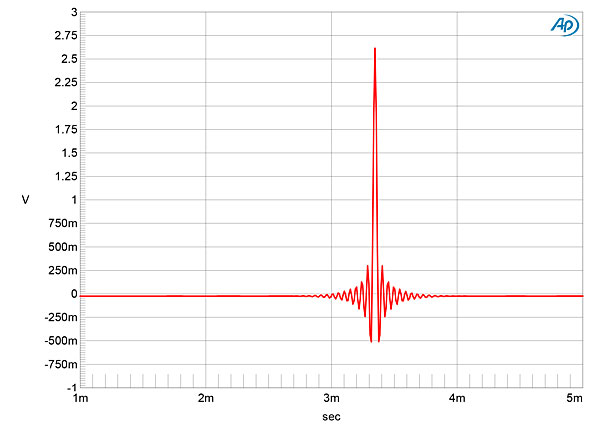
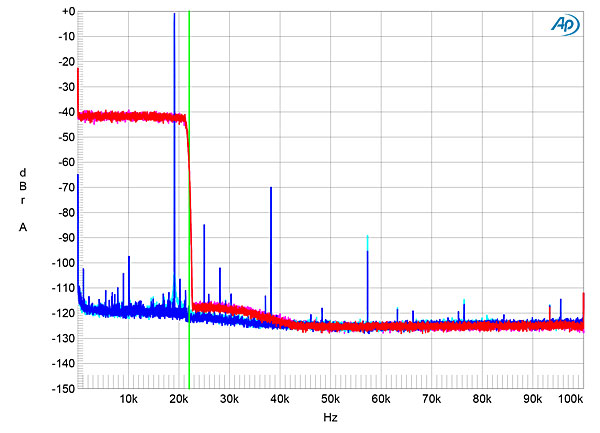
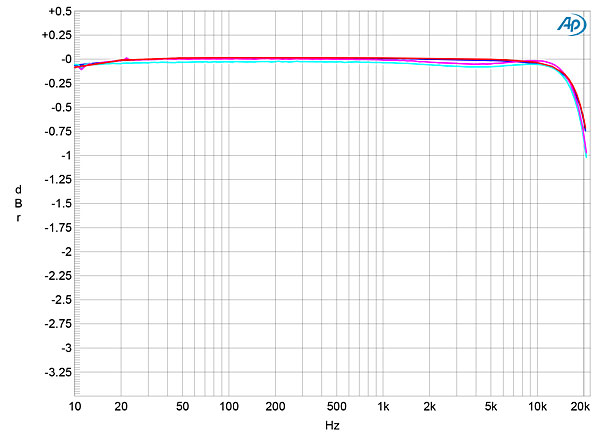
Channel separation (not shown) was superb, at >110dB in both directions from 20Hz to 4kHz, and still 90dB at 20kHz. The analog noise floor (fig.4) was low in level, but with some low-level power-supply–related artifacts at 120Hz and its harmonics present. With dithered data representing a 1kHz tone at –90dBFS (fig.5), the graph actually shows the spectrum of the dither noise used to encode the 16-bit test signal. With undithered data representing a 1kHz tone at exactly –90.31dBFS, the three DC voltage levels described by the data are well defined, but some high-frequency noise can be seen (fig.6).
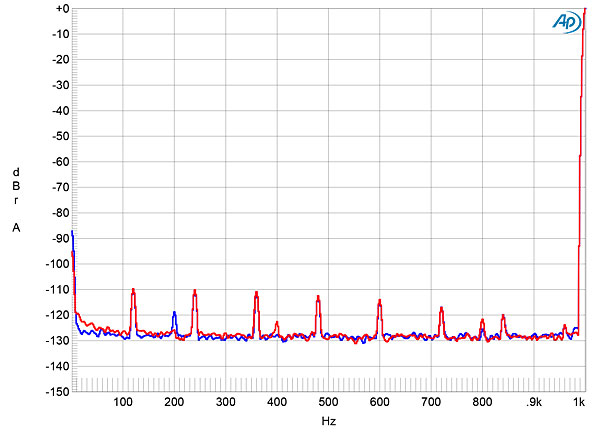
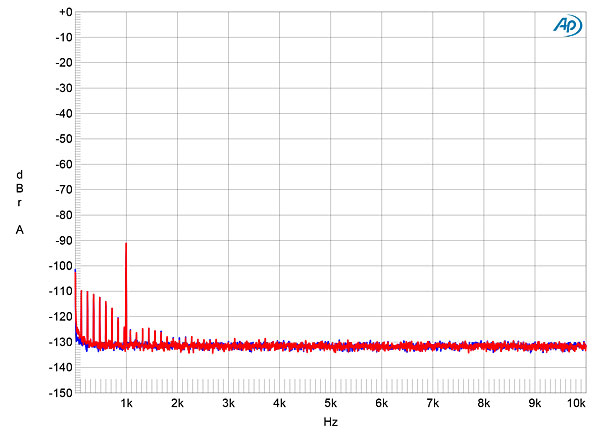
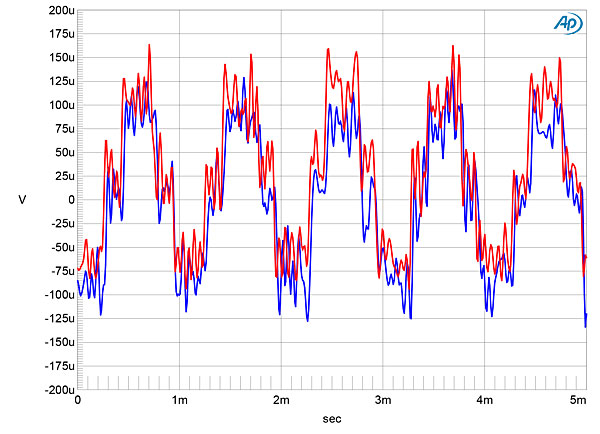
The spectrum of a full-scale 50Hz tone into 600 ohms (fig.7) indicates that the subjectively innocuous second harmonic is the highest in level, at –64dB (0.06%). Into the kinder 100k ohm load, this harmonic and the third dropped to below –90dB (0.003%). When tested for intermodulation distortion with an equal mix of 19 and 20kHz tones, the resultant spectrum (fig.8) looks hashy in the audioband, but this is an artifact of the 16-bit encoding. Actual intermodulation products are very low in level even into 600 ohms, the second-order difference product at 1kHz lying close to –100dB (0.001%).
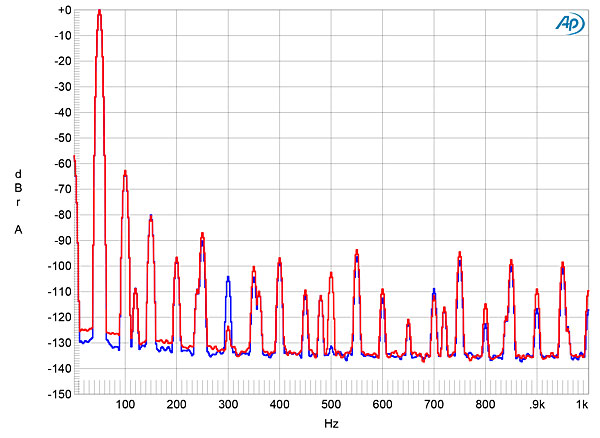
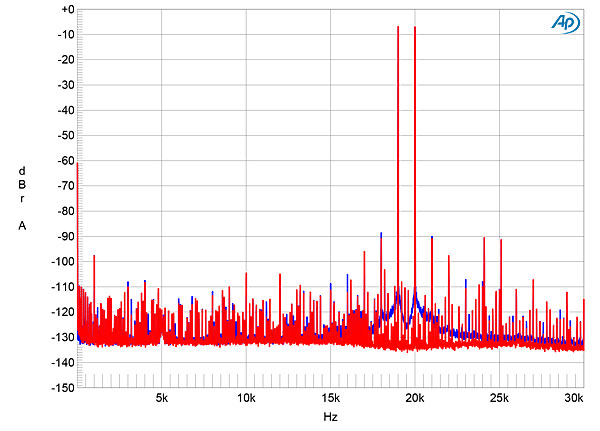
Finally, when I tested the Naim CD5 XS with 16-bit J-Test data, the two channels differed in how they handled the signal. In the right channel (fig.9, red trace), the spectral spike that represents the high-level tone at exactly one-quarter the sample rate is well defined, and the odd-order harmonics of the LSB-level, low-frequency squarewave are close to the correct levels (sloping green line). However, the left channel (blue trace) features significant smearing of the 11.025kHz spike, which I assume is due to random low-frequency jitter. This smearing can also be seen in fig.8—something is not working correctly in the left channel's circuitry, perhaps an issue with this sample of the Burr-Brown PCM1704 chip.
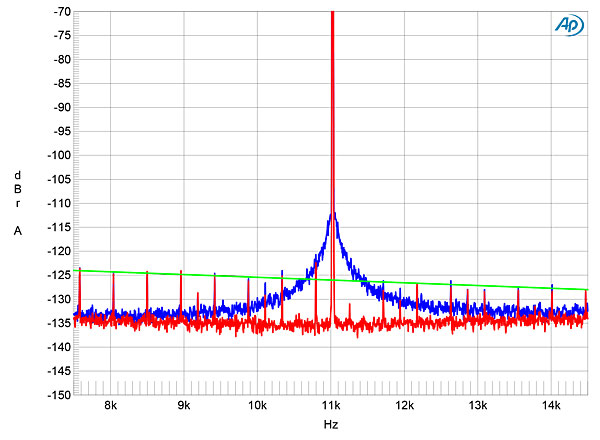
This Naim CD player's measured performance is overall acceptable, but its error correction is less tolerant of CD problems than other modern players that I have tested. This surprised me. In a conversation I had 40 years ago with Naim's founder, the late Julian Vereker, who had raced saloon cars in the 1970s, he emphasized that a racer can't win if he doesn't finish. For a CD player, the equivalent of finishing a race is making sure all disc errors, no matter how severe, are corrected.—John Atkinson

... Esoteric/TEAC Grandioso K1 or K-01X, the Marantz SA-10, the TAD/Pioneer D1000MK2 or D600 and the Yamaha CD-S3000.


Of course there are outfits that only make superb products.
That said,
being an Audiophile mandates individual product selections from a wide range of offerings thought to be the best gear selection available.
Audiophiles are music System builders with their own individual design preferences.
Being an Audiophile is a Mix & Match Statement.
No Audiophile could be happy with an all LINN system, an all Meridian system or even an all Goldmund system.
"Audiophile Nervosa" is the Hobby part of being an Audiophile.
Don't try the Audiophile thing at the Chevy Dealer, they'll send you across the street to the Auto Parts store to hang out with the hotrods.
Hmm, it makes me wonder if the Enthusiast Network would tolerate the Review of a Complete "One Brand Music System" ?
Wouldn't that be a hoot.
Who would be willing to do such a thing ? It'd make for some interesting reading.
Tony in Michigan

Compare several such systems. While there aren't a lot of mainstream companies that offer a full line of high quality stuff, I could see a real interesting "shootout" between:
Linn
McIntosh
Bryston (they do make a turntable)
Technics (their new TT's and speakers are interesting and well reviewed)
You could bill it in int'l terms - US vs Canada vs Britain vs Japan since all have a lot of successful high end audio equipment makers or in style terms since each company has a strong identity (and all but Technics have a sort of house sound). Is there a German or Scandanavian company that has a full line and meets Stereophile's review criteria for availability in the US?

Of course a big Shoot-out would be a gigantic undertaking. Who could house such an adventure?, RMAF possibly?
Europe has lots of music system suppliers.
I'm kinda looking forward to having a go with Mark Levinson and his latest music system.
Just now, we're able to have Genelec and even Kii make their entire music system contained inside their Loudspeaker enclosure. Phew!
The Genelec even does Room Eq corrections.
Tony in Michigan

I've still got my pair of Genelec 1031A's that I bought new in 1992. Right now just savin' up a li'l dough to have them serviced/refurbed by the Genelec rep in the US (lightning strike shorted one of the power supplies ~6 years ago) - that's one of the great things about Genelec, they still have the parts to refurb my 25 year old speakers to original spec's (early version, amps are discrete instead of IC's, w/ hand written serial numbers - higher peak SPL for better transients than later revisions). Their new pro monitors, besides the DSP and cast aluminum enclosures, show some very innovative thinking/design. Hell, all those waveguides you see now? Genelec was doing that in the 80's (and popularized it with the 1031/1030 models in the 90's).
That's one thing I don't see mentioned when talking about active speakers - passive x-overs seem to dull transients a smidge more than active x-overs.
It's not just Genelec with room correcting DSP, Dynaudio professional has been doing it for well over a decade (as has Genelec). I'm really surprised it's taken as long as it has for Dynaudio to release active monitors into the consumer market. In the pro audio near/mid-field monitor market, everyone follows what Genelec (and to a lesser extent Dynaudio) does. Barefoot Sound is another company to keep an eye on with their MicroMain and MiniMain systems.
Those new Kii speakers do sound intriguing, but I'm still not sold on moving D/A to the speaker - I don't want to have to replace my speakers when new/improved digital tech comes out and I don't want my volume control in the digital domain. Hell, I'm still running a pair of (partially rebuilt) Boston Acoustics T1030 speakers from 1990 (their last acoustic suspension flagship model) until my Genelecs are refurbed.
Man, I really miss acoustic suspension speakers being common... the bass is so much better. My T1030's bass is the best I've personally heard in a full range speaker, but I've not heard the Magicos - I'd assume their S3 and up models are better in the bass than my "90% of a Matrix 801 at 20% of the price" T1030's per the review in Audio Magazine (I think by Tom Norton, wish Audio was still around though many of their reviewers are here at Stereophile and Sound&Vision).

including B&O are exciting.
Not for the "hair shirt audiophile" who needs to ponder various Amps, Wires, Trusses, room treatments, room placement, peer approval.
I can imagine a listening room that only has two loudspeakers and no rack full of gear, the listener controls the speakers from his iPad. Just as we see Mr. JVS doing in Jana's video of Jason in his home system. hmm.
I want us to have what Jason has, without the fussy, a DSP music system.
Tony in Michigan
ps. the new "1" Genelec series is for the Consumer. ( in colors )

https://www.genelec.com/studio-monitors/sam-coaxial-studio-monitors (their "The Ones" point source range, really interesting design)
I didn't think they had a consumer version yet. I've always wanted a pair of their long discontinued S30C compact 3 way active with ribbon tweeter. The 1031A was the pro version of the HT208, mine are in the original wood veneer (w/ discrete amps) instead of the textured finish (and IC amps) of the later "producers version".

Yes, I think I am pointing to these 1's with their DSP.
Seems like all of the technically ( engineering ) capable, European Music Companies ( i.e. B&O thru Genelec ) are moving in this direction.
From here ( I suspect ), we'll see the Smart Phone entry level music System ( like the LG Tone ) with the Genelec type speaker being the Up-Grade .
Tony in Michigan

And I would also describe it as 'realistic', you have nailed Naim's approach 'down to a T', so to speak.
Three points:
1) Even the entry level Naim CD players are so good one wonders if they are competing with themselves? I realise that they are 'covering the market' with the variously priced players, but owning an earlier lower cost one I wonder if the differences between them is worth the extra cost.
2) At this price I don't see many adding the external power supply when even the lower cost power supply is almost as expensive as the player itself.
3) Using the Naim 'manual' CD tray is in fact much quicker than using the usual self-loading ones. And it never jams. Don't lose the puck :)
Tony in Michigan:
I don't think you would be in any way disappointed in an 'all Naim' system. I have just that with two exceptions, a Chord Dave DAC, mostly used via USB from a computer (I will no longer buy expensive DACs that use someone else's 5-10 dollar 'off the shelf' chip to do most of the work, which I see as merely implementing someone else's ideas as best you can), and Tannoy speakers.
And I arrived at Naim 'accidentally', I did not start off with Naim in mind. But now it's Naim CD player, phono stage (for my rare ventures into vinyl), pre and power amps, and 'streamer'.
I have no connection with Naim other than as a customer.